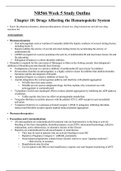Other
NR566 Week 5 Study Outline Chapter 18: Drugs Affecting the Hematopoietic System
- Course
- AIT Nursing (NR566)
- Institution
- Thompson River University (TRU )
NR566 Week 5 Study Outline Chapter 18: Drugs Affecting the Hematopoietic System • Know the pharmacodynamics, pharmacotherapeutics clinical use, drug interactions and adverse drug reactions for: Anticoagulants • Pharmacodynamics • Oral anticoagulants such as warfarin (Coumadin) inhi...
[Show more]



